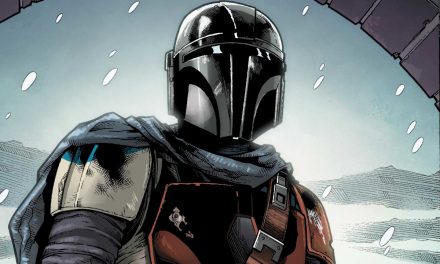This week from DC Comics we get the conclusion to a story that may not directly be a part of the Future State saga, but it does fold in with the Dark Knight: Death Metal storyline. Having not read the Death Metal story, I do not know if this falls within the actual events of Death Metal, or proceeds it. Either way, Generations Forged 1 concludes the story began in Generations Shattered 1,. One need not know of any events outside of these two issues to follow along.
In Generations Shattered, the Goneness (because the Nothing was already taken) devoured the universe and unraveled time and space throughout the multiverse. An older Booster Gold attempted to assemble a group of beings that could find a way to end this Goneness. He pulled both superhero and villain from across time from 1930’s Batman to 31st century Superboy.
At the very end of Shattered, we meet the Villain, Dominus. Dominus manages to intercept the heroes and scatter them to the four corners of time. Business accomplished for the day, he head home to his wife and children in a black and white existence.
Generations Forged 1 – Thankfully Heroes Are Fake
Reading stories like this Generations story make me glad superheroes and super powers are not real. After all, If you could bend space and time or possessed other powers, what would you do to protect your family? How far would you go to undo a harm done to them?
In the end Dominus cares not for power or control. He simply wants the family that life tore away from him. He uses his extreme powers to undo the Multiverse so he can restore the family he lost. Of course this does not sit well with our heroes and the trillions wronged by his actions.
The first half of this 80 page comic deals with the different groups of heroes in the times they were banished to. Once reunited, they figure attack Dominus and in the end restore time and space as it was.

Generations Forged 1 – The True Hero and More
This story arc does a solid job using and making relevant each of the heroes and villains that get pulled into events, even little Kamandi. Writers single out Kamandi early on and make it clear he is important, but he’s powerless. He spends most of the time running away from things until Skeet, Booster’s droid now a cybernetic arm, gives him an ability to fight with. In the end Kamandi’s presence lends one very important thing to the team – a conscience.
The heroes feel overwhelmed. Thus they use stong arm tactics and aggressiveness that the villains of the team thrive on in real life. When they finally get the upper hand, their instincts are to wipe Dominus out of existence, but Kamandi reminds them of who they are. They are heroes. They should find the better way, which they do of course.
I really would have liked to see more of the personalities clashing and intermixing in this series. When you only have two issues and roughly a dozen characters, though, they did what they could. They even do a good job foreshadowing future events in the DC timelines. Sinestro still wields the Green Lantern ring, but we see many hints towards the villain he will become. Likewise, Dr. Light and her team find themselves on Krypton, mere days before its destruction, but her actions not only solve her problem, but buy Jor-El and Lara the time they need to get their son to the planet they just found out about from Dr Light.
What did you think of the Generations 2-part story? Head over to DC Fanatics on Facebook and let us know what stood out to you.




![Cyberpunk 2077: You Have My Word #3 ~ A Cycle Of Revenge That Keeps On Going [Spoilery Comic Book Review]](https://thathashtagshow.com/wp-content/uploads/2022/01/cyberpunk-440x264.png)